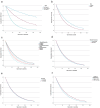Socio-demographic determinants of myelofibrosis outcomes in an underserved center and the SEER national database
- PMID: 39046510
- PMCID: PMC11358356
- DOI: 10.1007/s00277-024-05894-7
Socio-demographic determinants of myelofibrosis outcomes in an underserved center and the SEER national database
Abstract
The influence of demographic characteristics and social determinants on cancer outcomes is widely recognized in various malignancies but remains understudied in myelofibrosis (MF). This study aims to investigate social and demographic variables associated with MF survival. We retrospectively reviewed data of biopsy-proven MF patients from the Surveillance, Epidemiology and End Results (SEER) database (2000-2021) and Montefiore Medical Center (2000-2023), an underserved inner-city hospital. The SEER cohort included 5,403 MF patients and was predominantly Non-Hispanic (NH) White (82%) with a median age of 69 years. The age-adjusted incidence rate of MF was 0.32 cases per 100,000 person-years, increasing annually by 1.3% from 2000 to 2021. Two- and five- year overall survival rates were 69% and 42%, respectively. Worse cause-specific survival was associated with older age, male sex, and diagnosis before 2011 (year of Ruxolitinib approval). NH-Black ethnicity, unmarried status and lower median income were independent predictors of worse overall survival. The single-center analysis included 84 cases, with a median age of 66 years. NH-White patients comprised 37% of the sample, followed by NH-Black (28.5%). Two- and five- year overall survival rates were 90% and 61%, respectively, with NH-Black patients exhibiting the lowest median survival, although the difference was not statistically significant. Age was a significant predictor of worse survival in this cohort. NH-Black and Hispanic patients lived in areas with higher socioeconomic and demographic stress compared to NH-White patients. Overall, this study highlights the association of social and demographic factors with MF survival and emphasizes the need for equitable healthcare and further exploration of social-demographic factors affecting MF survival.
Keywords: Epidemiology; Ethnicity; Myelofibrosis; Myeloproliferative neoplasms; Social determinants of health.
© 2024. The Author(s).
Conflict of interest statement
The authors declare no competing interests.
Figures
References
-
- Forrest LF, Sowden S, Rubin G, White M, Adams J (2017) Socio-economic inequalities in stage at diagnosis, and in time intervals on the lung cancer pathway from first symptom to treatment: systematic review and meta-analysis. Thorax 72(5):430–436. 10.1136/thoraxjnl-2016-209013 10.1136/thoraxjnl-2016-209013 - DOI - PMC - PubMed
-
- Vince RA, Jiang R, Bank M et al (2023) Evaluation of Social Determinants of Health and prostate Cancer outcomes among Black and White patients: a systematic review and Meta-analysis. JAMA Netw Open 6(1):e2250416. 10.1001/jamanetworkopen.2022.50416 10.1001/jamanetworkopen.2022.50416 - DOI - PMC - PubMed
-
- Berger E, Delpierre C, Despas F et al (2019) Are social inequalities in acute myeloid leukemia survival explained by differences in treatment utilization? Results from a French longitudinal observational study among older patients. BMC Cancer 19(1):883. 10.1186/s12885-019-6093-3 10.1186/s12885-019-6093-3 - DOI - PMC - PubMed
MeSH terms
LinkOut - more resources
Full Text Sources


